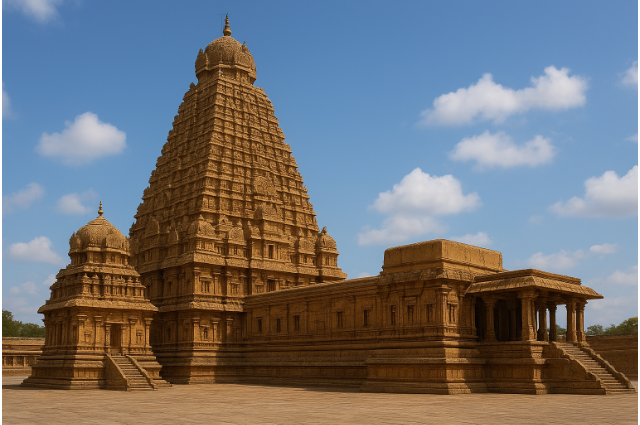
India is a virtuous country; many religions are followed here. In the Hindu religion, people believe in God and are lost in their devotion to God. They often go to the temple for worship. Tamil Nadu is a state in South India that has a large number of temples, including some great, ancient, well-known temples with old structures made of rocks that attract people. Brihadeshwara Temple is a perfect place to explore and learn about the culture of the temples.
Location and Architecture
Brihadeshwara Temple, which is also known as Big Temple, is a World Heritage site located in the town of Thanjavur in the Indian state of Tamil Nadu. Built in the 11th century by the Chola dynasty, the temple is dedicated to Lord Shiva and is one of the most famous and visited temples in India. The temple was built by the Chola king Raja Raja Chola I, who ruled from 985 to 1014 CE. The construction of the temple took place between 1003 and 1010 CE and involved the work of thousands of skilled artisans, sculptors, and craftsmen. It was a symbol of the Chola dynasty's power and influence.
It was designed as a grand temple complex, with a towering Vimana that is over 200 feet tall. The Vimana is made of granite and features intricate carvings and sculptures that depict scenes from Hindu mythology. The Brihadeshwara Temple is a testament to the rich cultural and architectural heritage of the Chola dynasty. It was built using a system of interlocking stones that allowed it to withstand earthquakes and other natural disasters. The temple also features several water tanks and channels that were used to store and distribute water. This temple faces east and once had a water moat around it, which has now been filled up. A fortified wall now runs around this moat. The two walls have ornate gateways called gopurams. The main gateways are on the east side. The first one is called the Keralantakan thiruvasal, which means "the sacred gate of the Keralantakan". The word was the surname of the king Raja Raja who built it. The east wall has a standing Shiva, Pashupatinath murti, plus two dvarapalas flanking the pathway from Andha mandapam.
The south wall has Bhikshatana, Virabhadra, Dakshinamurti, Kalantaka, Nataraja, plus two dvarapalas. The west wall has Harihara, Lingodbhava, Chandrasekhara without Prabhavati, Chandrasekhara with Prabhavati, plus dvarapalas. The north wall has Ardhanareshwara, Gangadhara without Parvati, Pashupata murti, Shiva Alinga murti, plus two dvarapalas.
The Brihadeshwara Temple is not just a religious site, but also a cultural and historical landmark. It is a popular destination for tourists and pilgrims alike, who come from all over the world to admire its magnificent architecture, explore its rich history, and seek blessings from Lord Shiva. The Brihadeshwara Temple is enough to explain the beauty of Thanjavur. The structure of this temple is strongly made of old stones. Moreover, the paintings on the wall of the Big Temple explain many things about the kingdom of Raja Chola. A day is not enough to feel the beauty. To explain the architecture perfectly, an imposing entrance that exposes the beauty of the Big Temple, which is situated at the last, seems to have a three-dimensional appearance, a wide view of the Nataraja temple, a shrine with Nataraja mandapam, the trinity, the combination of the trio, the converging corridor, and a single stone Nandi bull statue.
A single stone Nandi bull statue
A Nandi bull statue facing the mukth mandapam weighs about 25 tonnes. It is carved out of a single stone, and the length of this Nandi is 16 feet, and the height is 13 feet. This Nandi is the second biggest in the world. The Nandi will always face the sanctum of the Shiva temple.
The mystery behind the lack of a shadow
The temple's architectural precision is evident in its layout, which aligns perfectly with the cardinal directions. Every component of the temple, from its entrances to the sanctum, is meticulously planned and positioned. The phenomenon of the disappearing shadow isn't just an architectural curiosity; it carries profound symbolic significance. In Hindu philosophy, shadows often represent the temporary illusionary nature of the world, and their fleeting presence symbolizes the transience of life. By engineering a temple that loses its shadow at noon, the Chola architects might have been trying to convey the idea of transcending the ephemeral world and moving towards the eternal divine light.
The biggest mystery that surrounds this temple is its shadow, which doesn't fall on the ground. The reason behind this is not magic, but the credit goes to the genius engineers who built it. It is said that the way the stones cascade to build the structure of this temple, it creates an illusion that the shadow of the temple never reaches the ground. When the temple was completed, King Raja Raja Chola asked the architect if this temple was ever going to fall down, to which the master craftsman replied, "even its shadow will not fall on, raja". Some researchers have stated that this design could have been an astronomical tool to mark the equinoxes, given the ancient Indian expertise in astronomy. Others believe that it may have been a deliberate statement of power and prestige by the Chola dynasty, showcasing their mastery over art, architecture, and science. Regardless of the underlying reason, the Brihadeshwara Temple stands as an enduring symbol of ancient India's architectural and scientific accomplishments.
References
